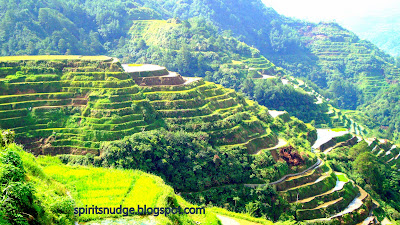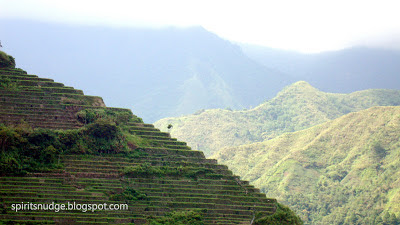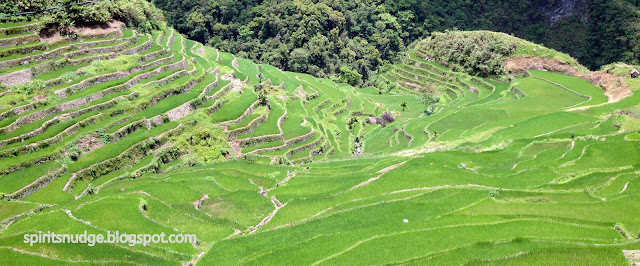Banaue Rice Terraces: A Tour Like No Other
The first question I asked the organizers of Route +63 when my friend, Glenn, and I were exploring the possibility of joining the Banaue tour was whether my 13 year old son could manage the trek involved. I would find out during the tour itself that I had asked the wrong question. The question should have been, “could a 40 something woman, whose main physical exercise during the last couple of years is malling, manage the trek.” I was literally huffing and puffing much of the time. It certainly would not count as my kind of tour, much less my kind of vacation.
Our trip to Banaue is not a typical tour. Like all the tours organized by Route +63, it had a volunteering component. Our trip then was aptly called Banaue Voluntour. The focus of our volunteer work was to help rehabilitate the Banaue Rice Terraces, one of our country’s cultural heritages. While planting is the most common activity done by different volunteer groups, the task laid before us for our Bachang (which roughly translates to Bayanihan or volunteering together) was to help clear a terrace so that it could be prepared for tilling and planting.
 According to the representatives of the provincial government who served as our tour guide, one of the challenges facing the rice terraces communities is that many of the owners’ heirs have lost interest in farming and have followed the lure of the big cities. Many terraces then had been abandoned. So, our group through the assistance of provincial government representatives worked with barangay leaders to clear and prepare the lands for tilling by other members of the community. Farm implements purchased were donated to the community after the activity.
According to the representatives of the provincial government who served as our tour guide, one of the challenges facing the rice terraces communities is that many of the owners’ heirs have lost interest in farming and have followed the lure of the big cities. Many terraces then had been abandoned. So, our group through the assistance of provincial government representatives worked with barangay leaders to clear and prepare the lands for tilling by other members of the community. Farm implements purchased were donated to the community after the activity.
This volunteering aspect of the trip, aside from Banaue being in my bucket list, was what drew me to this trip. Volunteering is in my blood and I was hoping that by keeping my son engaged in activities like this he will one day internalize the spirit of volunteerism, too. The tour side was a freebie, adding fun and color to the inherent joy that comes from being able to contribute to a cause bigger than one's small world.
 |
| An ading taking care of her younger sibling (Batad Village) |
More importantly the rigorous treks to Batad, Viewpoint, and Tam-an Village brought me face to face with my midlife transition. One of the key issues that one has to face in midlife is the crisis of limits. Midlife is a time in one’s life when one realizes there is a limitedness to one’s life on earth. This can be overwhelming in the face of the many things that one still longs to accomplish for oneself, for one’s loved ones, and for the bigger society and the generations to come.
 |
| The art of weaving in Tam-an Village |
I am truly grateful to Glenn who prodded me to join the Batad leg when I woke up that Sunday morning sore all over from the trek the previous day. I can still hear him nagging me when I refused to get out of bed 30 minutes before departure time: “Sige na, La. Pwede naman tayo huminto ‘pag hindi na natin kaya. Saka sabi ni Ella, kelan pa natin gagawin ito? Mas mahirap pag 50 na tayo.” I am also filled with gratitude to my companions and our guides who really reached out to me. I didn’t really mind it when Glenn jokingly told our guide, “Pasensiya ka na. May kasama tayong Imeldific.” All that mattered was to manage the obstacle course laid out by nature before me. Any help was welcome. And help always came even from people I least expected it from, like Abby who offered to carry my slippers for me when it was too slippery and my gray matter brought images of me losing my balance if I had to carry my slippers. Silly. . . but that was me in my most vulnerable.
Somehow the trip reminded me that in spite of the reality of limits, our limitedness is only a function of how much limits we impose on ourselves. I for one tend to put a lot of limits to what I can do and this applies to many aspects of life. What I went through in this voluntour was a reminder that even in moments of extreme vulnerability and of extremely limited options, there are choices. My indomitable spirit is the greatest friend of my midlife years. No wonder then that one of the joys of this trip for me was seeing my son fearless and imbued with an adventurous spirit and a deep sense of wonder despite his limited opportunities for rigorous outdoor activities like this.





Comments
Post a Comment